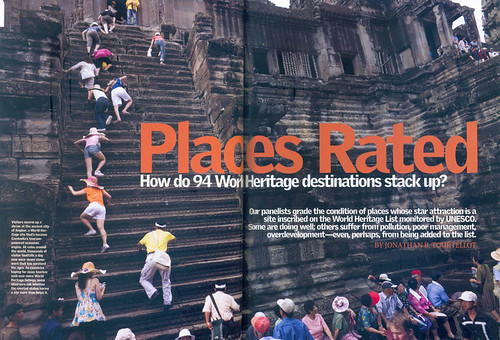National Geographic Traveler’s November/December issue features this article (Pssst my Angkor companions, check this out, see those tourists sprawled over the temple steps?) and this telling image on page 112:
(View larger version here.)
Incidentally, a Destination Scorecard survey recently conducted by Traveler and its National Geographic Center for Sustainable Destinations with George Washington University asked 419 well-traveled experts worldwide to rate 94 World Heritage destinations according to aesthetic appeal, quality of tourism management, social and cultural integrity, overall outlook for the future and such other criteria. (Check out the full criteria list here.) Angkor earned a dismal score of 48, dropping 4 points from its 2004 score. (To think that just 5 years earlier I was drooling over an Angkor article in Traveler’s 50 Places of a Lifetime special collectors' issue. *sigh*) A score of 48 means that the site is in moderate trouble (all criteria medium-negative or a mix of negatives and positives). The experts say that yes, Angkor and its environs rate high in aesthetics and conservation efforts, but very poorly overall in terms of sustainable tourism and destination stewardship. As in the article I mentioned above, the magazine reports that the water table has become “so depleted by hotel wells that it is destabilizing the foundations of the ruins”. So yeah, Siem Reap and Angkor may be sinking.
In an impoverished country which relies solely on tourism for its lifeblood, it's no wonder that money is prioritized over preservation and sustainability. Even as Cambodia still suffers from the trauma wrought by the Khmer Rouge in the late `70s, those in government continue to fatten their pockets with the fruits of a continuously growing tourism industry. In the meantime, its citizens, most of them ethnic Khmer, descendants of the proud, highly-cultured society who built the famed temples in ancient times, struggle to eke a living out of the ruins of their heritage. (I cannot say how sad it is that I mean that literally.) Children work during the day selling books, postcards and souvenirs around the temples. A lot of young people, I imagine, are studying to become tour guides as one stands to earn a decent income in that occupation. Aside from hotels, ranging from budget guesthouses to the expensive boutique and five-star resort and spas, karaoke bars and who knows what other recreational establishments, are built every day. Siem Reap is fast losing its character as it is literally overrun by busloads of tourists (that includes those coming in planes and taxis, too. *cough*) I read elsewhere that a few years ago, horror of horrors, there were plans of installing a cable car network in Angkor. Let’s hope they never try to take that up again.



No comments:
Post a Comment